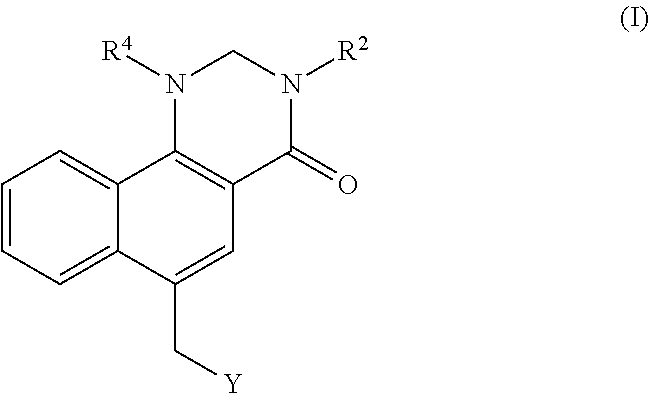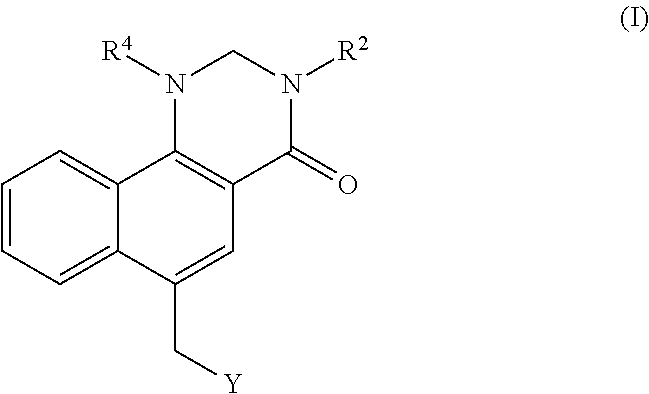Dihydrobenzoquinazolinone M1 receptor positive allosteric modulators
a technology of dihydrobenzoquinazolinone and allosteric modulator, which is applied in the field of dihydrobenzoquinazolinone compounds, can solve the problems of behavior deficit, progressive memory impairment, loss of language and visuospatial skills, etc., and achieves the effect of not changing the pathology of the disease, and therapy has not been shown to change the underlying disease pathology
- Summary
- Abstract
- Description
- Claims
- Application Information
AI Technical Summary
Problems solved by technology
Method used
Image
Examples
example 1
1,5-Anhydro-2,3-dideoxy-3-{6-[(1-methyl-1H-indol-4-yl)methyl]-4-oxo-1,4-dihydrobenzo[h]quinazolin-3 (2H)-yl}-L-threo-pentitol
[0198]
Synthesis of (3R,4S)-4-Aminotetrahydro-2H-pyran-3-ol
[0199]
[0200]A jacketed flask equipped with an overhead stirrer and a thermocouple was charged with 23.0 L of MeOH, and cooled to 5° C. Potassium hydroxide (1.574 kg, 28.05 mol) was added to the flask, and the resulting solution was aged until homogeneous and recooled to 5° C. Tetrahydro-4H-pyran-4-one (1.00 kg, 10.0 mol) was then added at a steady rate over 20 min, and the resulting solution was aged for 20-30 min. A solution of iodine (2.778 kg, 10.95 mol) in 18.5 L of MeOH was then added via mechanical pump at a steady rate over 90-100 minutes. After an additional 30 min, the solution was warmed to rt and toluene (42.0 L) was added. The resulting slurry was concentrated in vacuo to a volume of ˜8.4 L. Additional toluene (8.4 L) was added and the resulting solution was concentrated to a volume of 8.4 L...
example 2
1,5-Anhydro-3-{6-[(6-chloropyridin-3-yl)methyl]-1-methyl-4-oxo-1,4-dihydrobenzo[h]quinazolin-3(2H)-yl}-2,3-dideoxy-L-threo-pentitol
[0222]
[0223]To a solution of 6-bromo-3-[(3R,4S)-3-hydroxytetrahydro-2H-pyran-4-yl]benzo[12]quinazolin-4(3H)-one (see Example 1, 3.65 g, 9.73 mmol) in 20 mL of THF at 0° C. under an atmosphere of nitrogen was added (2-chloro-5-pyridyl)methylzinc chloride (24.3 mL, 0.5 M in THF, 12.2 mmol) and bis(tri-tert-butylphosphine)palladium(0) (3 mol %). The reaction was warmed to rt, stirred for 15 min, then recooled to 0° C. and quenched with water (50 mL). The mixture was diluted with dichloromethane and water, and a beige solid was removed via filtration. The filtrate was extracted 2× with dichloromethane and the combined organic fractions were dried over sodium sulfate, filtered, and concentrated in vacuo. The residue was triturated with dichloromethane, and the resultant white solid was collected via filtration, washed with dichloromethane, and dried to provid...
example 3
1,5-Anhydro-2,3-dideoxy-3-[6-{[6-(methylsulfanyl)pyridin-3-yl]methyl}-4-oxo-1,4-dihydrobenzo[h]quinazolin-3(2H)-yl]-L-threo-pentitol
[0228]
[0229]To a solution of 6-[(6-chloropyridin-3-yl)methyl]-3-[(3R,4S)-3-hydroxytetrahydro-2H-pyran-4-yl]benzo[h]quinazolin-4(3H)-one (see Example 2, 0.065 g, 0.15 mmol) in 2 mL of MeOH was added sodium thiomethoxide (21.6 mg, 0.308 mmol) and 1 mL of DMF. The mixture was heated in a sealed tube at 100° C. for 24 h. Additional sodium thiomethoxide (0.100 g, 1.43 mmol) was added and the reaction was heated in a sealed tube at 140° C. for 8 hours, cooled to rt, and diluted with dichloromethane and water. The aqueous layer was extracted 3× with dichloromethane and the combined organic fractions were dried over sodium sulfate, filtered, and concentrated in vacuo. The residue was purified via silica gel chromatography, eluting with 0-5% methanol in dichloromethane, to provide 3-[(3R,4S)-3-hydroxytetrahydro-2H-pyran-4-yl]-6-{[(6-methylthio)pyridin-3-yl)methy...
PUM
| Property | Measurement | Unit |
|---|---|---|
| weight | aaaaa | aaaaa |
| volume | aaaaa | aaaaa |
| volume | aaaaa | aaaaa |
Abstract
Description
Claims
Application Information
 Login to view more
Login to view more - R&D Engineer
- R&D Manager
- IP Professional
- Industry Leading Data Capabilities
- Powerful AI technology
- Patent DNA Extraction
Browse by: Latest US Patents, China's latest patents, Technical Efficacy Thesaurus, Application Domain, Technology Topic.
© 2024 PatSnap. All rights reserved.Legal|Privacy policy|Modern Slavery Act Transparency Statement|Sitemap



